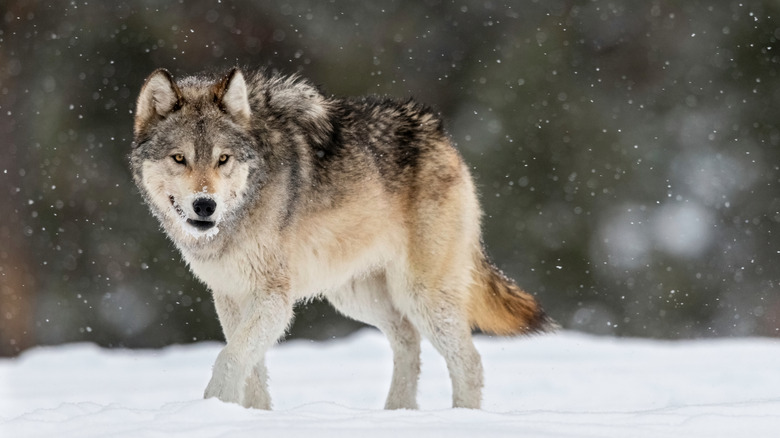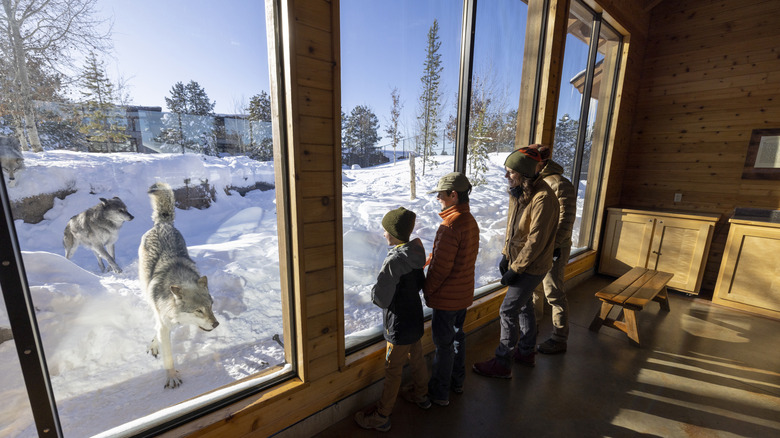The Meaning Behind Yellowstone's Strict 'No Howling' Rule Explained
Is Yellowstone National Park on your list of things to see this summer? It'd be no surprise if so — U.S. national parks are trending on people's travel lists in 2025, and due to vivid geothermal activity, Yellowstone is widely considered one of the most unusual national parks in the world. But America's first national park has so much more than geysers and prismatic springs — it's also abundant with fascinating wildlife. In particular, Yellowstone is renowned as the best place in the world to witness native gray wolves.
Nearly 100 years ago, wolves disappeared entirely from Yellowstone due to overhunting, and their extinction from the parklands upset the park's indigenous species, nearly destroying the natural ecology. Thanks to a massive restoration project in the 1990s, the park regained its wolf population, and there are now around 120 wolves that roam its lands. But in order to maintain balance and allow these creatures to flourish in their natural habitat, it's important that human visitors avoid interfering with their regular activities.
While to us humans, imitating these creatures' nocturnal calls may feel like a fun way to connect with nature, it can produce anxiety for wolves themselves. To a wolf, an unfamiliar howl could sound like a warning or a battle cry, making them feel threatened and put on the defensive. Therefore, visitors are not permitted to imitate a wolf in any way within the park, including mimicking their howling calls to one another. It may not be one of the most common mistakes first-timers make while visiting a national park, but it's surely one many have made. It violates the Code of Federal Regulations Title 36 § 2.2 (Wildlife Protection), which bans "the feeding, touching, teasing, frightening or intentional disturbing of wildlife" within any U.S. national park.
How to safely and respectfully observe wolves at Yellowstone
Just because you can't howl in Yellowstone doesn't mean you can't appreciate the wildlife. In fact, observing them in the correct way is one of the best ways to learn about their behavior and appreciate it. Since wolves were reintroduced into the park in 1995, professional naturalists have been watching them to monitor behavior and population trends, and you can join them. One of the most special, unique experiences to Yellowstone is going on an early-morning wolf-tracking excursion. While wolves are the focus of these tours, guides help visitors spot elk, bison, and bears as well, using high-quality scopes and binoculars from the safety of specialized tour vehicles.
You can also keep your eyes peeled for wolves while moving on your own throughout the park (just remember not to howl with excitement if you see one!). Visit the Albright Visitor Center in Mammoth or the Lamar Buffalo Ranch to get an overview of their activities and behavior before setting out. Dawn and dusk are the best times to spot these nocturnal pack animals, and though they're most active in winter, cool shoulder season months offer a good balance of sightings and bearable weather. If you're lucky, in spring, you might even be able to see the wolves with their babies.
In addition to not howling, Yellowstone wildlife viewing guidelines instruct visitors to stay at least 100 yards away from wolves at all times. You should never attempt to approach one on foot (the safest viewing spot is within an automobile) and should stay quiet so as not to disturb their natural behavior. Follow these directives, and you may be graced with the unforgettable experience of witnessing the mighty wolves howl and respond to each other in their native habitat.

